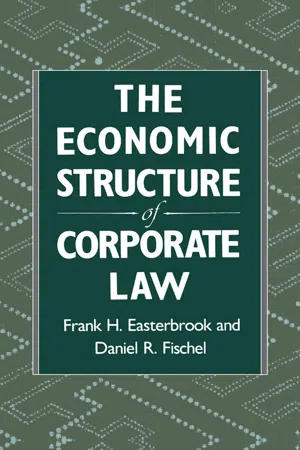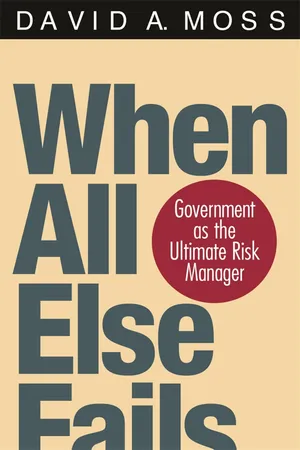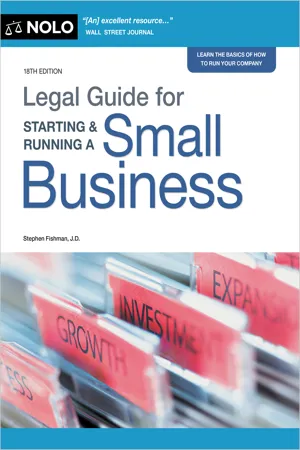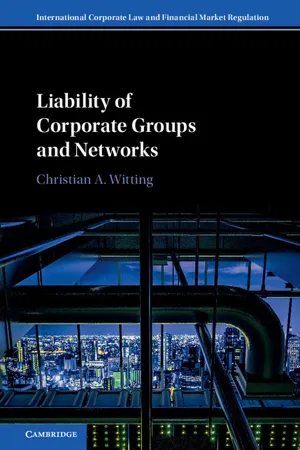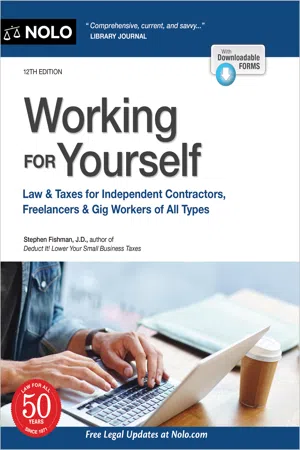Business
Limited Liability
Limited liability refers to the legal protection that limits an individual's financial liability to the amount they have invested in a business. This means that the personal assets of business owners are safeguarded in the event of business debts or legal actions. Limited liability is a key feature of corporations and limited liability companies, providing a level of security for business owners.
Written by Perlego with AI-assistance
Related key terms
1 of 5
12 Key excerpts on "Limited Liability"
- eBook - ePub
- Frank H. Easterbrook, Daniel R. Fischel, Frank; Daniel R. Easterbrook; Fischel(Authors)
- 1996(Publication Date)
- Harvard University Press(Publisher)
2 Limited LiabilityLimited Liability is a distinguishing feature of corporate law—perhaps the distinguishing feature. Although partners are personally liable for the debts of the partnership, shareholders are not liable for the debts of the corporation. We have emphasized the contractual nature of corporate law, yet Limited Liability seems to be the antithesis of contract, a privilege bestowed on investors. In exchange for this boon, many argue, corporations should be required to submit to regulation, or do favors for customers and workers and neighbors.Not so fast. Limited Liability may be depicted as anticontractual only if it is inaccurately described. Corporations do not have “Limited Liability”; they must pay all of their debts, just as anyone else must (unless, in either event, they receive absolution in bankruptcy). To say that liability is “limited” means that the investors in the corporation are not liable for more than the amount they chip in. A person who pays $100 for stock risks that $100, but no more. A person who buys a bond for $100 or sells goods to a firm for $100 on credit risks $100, but no more. Managers and other workers are not vicariously liable for a firm’s deeds. No one risks more than he invests.Limitation of liability to the amount invested is an attribute of most investment, not just of corporate law. Debt investors in sole proprietorships, general or limited partnerships, business trusts, and other ventures possess Limited Liability. Suppose a bank lends $100 to a partnership, and the partnership’s liabilities later exceed its assets. The bank may lose the $100, but it will not be required to contribute any extra money. Its liability is limited to its investment, exactly as the shareholder’s liability is limited in a corporation. Employees and other contributors of human capital enjoy Limited Liability no matter the organizational form. Equity investors in publicly held corporations, limited partnerships, and business trusts need not contribute extra capital if the venture fails. The instances of “unlimited” liability are few. The general partners of a partnership may be required to contribute additional capital to satisfy the association’s debts. Even here, though, a discharge in bankruptcy enables the partner to limit his liability to a portion of the assets he possesses at the time the partnership requires more capital. (Some assets are exempt from attachment even in bankruptcy.) Limitations on liability turn out to be pervasive. - eBook - PDF
- William Kingston(Author)
- 2021(Publication Date)
- Peter Lang Group(Publisher)
History Chapter 22 The Evolution of Limited Liability from Its Dublin Origin Limited Liability allows sharing in ownership of a business without any responsibility for debts which that business may incur. The most that the investor can lose if it fails is the amount that the share in it has cost. Although the modern Corporation depends absolutely upon it for its existence, this legal privilege is taken for granted, like the expectation that the sun will rise tomorrow. Almost no Manager is aware that his business exists because of this specific piece of property law, and indeed this lack of awareness is also true of many teachers of Management. General Limited Liability is quite a modern phenomenon, and its origin can be precisely dated: this is in the 1782 ‘Anonymous Investors’ Act of the Irish Parliament, passed in the building just across from the Front Gate of Trinity College, which is now the Bank of Ireland. This is the first time that the concept was embodied in law anywhere in the world. Yet it is scarcely known about. There is no reference to it, for example, in the thorough study of Limited Liability by Bainbridge and Henderson (2016). The Economist’s change of view In fact, a December 31, 1999 article in The Economist, which prides itself on its accuracy, entitled ‘The Key to Industrial Capitalism: Limited Liability’, contains the following: In 1811, from America, came the first limited-liability law. New York State brought in one for manufacturing companies. Its popularity, and the flight of capital to states 304 chapter 22 with Limited Liability from those without, led most American states to follow suit. In 1854, Britain, the world's leading economic power, did so too. The Economist disapproved: if Limited Liability was desirable, we said, market forces would provide it. - Ernest Lim(Author)
- 2020(Publication Date)
- Cambridge University Press(Publisher)
5 This is because absent Limited Liability, shareholders will be liable for the debts of companies and hence the less wealthy the other shareholders are, the more the other shareholders have to shoulder the debts of the companies. Putting it differently, the value of an investor’s share will increase if the other shareholders are wealthy. Third, Limited Liability enables shareholders to diversify their investments by incentivis- ing them to invest in different companies in different industries and different jurisdictions. 6 UnLimited Liability will discourage diversification as shareholders would have to incur cost in monitoring their invest- ments. Finally, Limited Liability promotes monitoring by creditors. 7 This is because, given that Limited Liability reduces shareholders’ incentives to monitor the company, and because creditors cannot assert claims against the shareholders’ assets, they will be incentivised to monitor the company to ensure that it does not become insolvent. While these rationales for Limited Liability are derived from the context of individual shareholders and not the context of corporate groups, the protection of Limited Liability is extended to each individual company within the group, including the parent and its subsidiaries. 8 The question then is whether these rationales still hold true in a corporate group structure; in other words, the issue is whether the advantages of Limited Liability are sufficiently compelling to justify its retention for a parent company (or its controlling shareholder or other companies within the corporate group) where the delinquent subsidiary is unable to compen- sate the victims for its tortious acts. 4 Paul Halpern, Michael J Tebilcock and Stuart McLean Turnbull, ‘An Economic Analysis of Limited Liability’ (1980) 30 University of Toronto Law Journal 117. 5 Larry E Ribstein, ‘Limited Liability and Theories of the Corporation’ (1991) 50 Maryland Law Review 80 at 102–3.- eBook - PDF
When All Else Fails
Government as the Ultimate Risk Manager
- David A. Moss(Author)
- 2004(Publication Date)
- Harvard University Press(Publisher)
Limited Liability is attractive to shareholders precisely because it eliminates, in Governor Lincoln’s words, the “risk of utter ruin.” 87 Although an increased chance of loss is shifted onto creditors, each creditor’s maximum possible loss remains unchanged. The most a creditor ever stands to lose is the amount of his loan, whether under a limited or an unLimited Liability regime. An unLimited Liability share-holder, by contrast, always stands to lose everything he owns. In the early nineteenth century, as we have seen, he could even lose his free-dom, since delinquent debtors were often consigned to debtors’ prisons. The introduction of Limited Liability thus implies a trade-off between the magnitude and the probability of loss. The shareholder’s maximum possible loss (magnitude) is capped at a much-reduced level, while the creditor’s probability of loss is simultaneously increased. As it turns out, there is good reason to believe that the overall effect of this trade-off may be positive, with the benefit to shareholders exceeding the cost to credi-tors. To understand why, we need only recall Daniel Bernoulli’s famous solution to the St. Petersburg Paradox. Bernoulli’s key insight was that people tend to value each additional dollar less than the one before. Almost anyone would love to win $1 mil-lion in a lottery, and most of us would be even happier about winning $100 million. But Bernoulli’s principle implies that the pleasure derived from winning $100 million would be less than one hundred times as great as that from winning $1 million. It also suggests that we would prefer a 0.01 chance of winning $1 million to a 0.0001 chance of win-ning $100 million. The same logic applies in reverse in the case of losses. People tend to dislike large losses disproportionately more than small ones. So losing all of one’s net worth—say, $100,000—would be more than one hundred times as painful as losing 1 percent of it, or $1,000. - eBook - ePub
Shareholder Democracies?
Corporate Governance in Britain and Ireland before 1850
- Mark Freeman, Robin Pearson, James Taylor(Authors)
- 2011(Publication Date)
- University of Chicago Press(Publisher)
CHAPTER SEVEN Limited Liability and Company Dissolution Sound city men … all along have clung to the opinion, that there can be no protection to the public from mismanagement by banks, unless the responsibility of the shareholders is without limit.— Times (London), 22 May 1844 The preceding three chapters trace the decline of the active shareholder and the growing marginalization of investors in company decision making. This has been explained partly by the increasing size of companies and by a transition in the motivations for investment. In this chapter we consider the ways in which companies sought to safeguard the “financial” interests of their investors, which were coming to predominate as the joint-stock economy and the secondary market for shares grew during our period. In particular, we examine the issue of shareholder liability, which exercised legislators, political commentators, company promoters, and individual shareholders during this period. The introduction of general Limited Liability in the 1850s is well documented, but the legal framework regulating the liabilities of shareholders before this time remains imperfectly understood. 1 Moreover, the issue has usually been viewed from the point of view of legislators and political economists rather than the investors and company promoters who were subject to it. 2 It was the latter who were required, where their companies remained unincorporated, to balance the need for capital with the desire of investors for protection from large liabilities. They also needed to protect themselves from being held personally responsible for company debts - Stephen Fishman(Author)
- 2023(Publication Date)
- NOLO(Publisher)
RESOURCE For an in-depth discussion of LLCs and step- by-step guidance on creating one, see Form Your Own Limited Liability Company, by Anthony Mancuso (Nolo). Limited Personal Liability As with a corporation, all owners of an LLC enjoy limited personal liability. This means that being a member of an LLC doesn’t normally expose you personally to legal liability for business debts and court judgments against the business. Generally, if you become an LLC member, you risk only your share of capital paid into the business. You will, however, be responsible for any business debts that you personally guarantee (of course, you can reduce your risk to zero by not doing this) and for any wrongs (torts) that you personally commit (a good insurance policy should help here—see Chapter 12). CHAPTER 1 | WHICH LEGAL FORM IS BEST FOR YOUR BUSINESS? | 23 Corporations and LLCs Use Different Language Although there are many similarities between corporations and LLCs, there are many differences as well— especially when it comes to terminology, as shown in the following chart. Concept Corporation Word LLC Word What an owner is called Shareholder Member What an owner owns Shares of stock Membership interest What document creates the entity Articles of Incorporation (or, in some states, Certificate of Incorporation or Charter) Articles of Organization What document spells out internal operating procedures Bylaws Operating Agreement By contrast, as discussed above, owners of a sole proprietorship or general partnership have unLimited Liability for business debts, as do the general partners in a limited partnership (and limited partners who take part in managing the business—discussed below). Number of Owners Every state allows an LLC to be formed by just one person. This means that if you plan to be the sole owner of a business and you want to limit your personal liability, you have a choice of forming a corporation or an LLC.- No longer available |Learn more
- (Author)
- 2014(Publication Date)
- Learning Press(Publisher)
The economic rationale for this is that it allows anonymous trading in the shares of the corporation, by eliminating the corporation's creditors as a stakeholder in such a transact ion. Without Limited Liability, a creditor would probably not allow any share to be sold to a buyer at least as creditworthy as the seller. Limited Liability further allows corporations to raise large amounts of finance for their enterprises by combining f unds from many owners of stock. Limited Liability reduces the amount that a shareholder can lose in a company. This increases the attraction to potential shareholders, and thus increases both the number of willing shareholders and the amount they are likel y to invest. However, some jurisdictions also permit another type of corporation, in which shareholders' liability is unlimited, for example the unLimited Liability corporation in two provinces of Canada, and the unlimited company in the United Kingdom. Perpetual lifetime Another advantage is that the assets and structure of the corporation may continue beyond the lifetimes of its shareholders and bondholders. This allows stability and the accumulation of capital, which is thus available for investment in larger and longer-lasting projects than if the corporate assets were subject to dissolution and distribution. This was also important in medieval times, when land donated to the Church (a corporation) would not generate the feudal fees that a lord could cl aim upon a landholder's death. (However a corporation can be dissolved by a government authority, putting an end to its existence as a legal entity. But this usually only happens if the company breaks the law, e.g. fails to meet annual filing requirements, or in certain circumstances if the company requests dissolution.) Ownership and control Persons and other legal entities composed of persons (such as trusts and other corporations) can have the right to vote or receive dividends once declared by the Board. - eBook - PDF
- Christian A. Witting(Author)
- 2018(Publication Date)
- Cambridge University Press(Publisher)
191 Although not encouraged in today’s deregulated world, direct government investment in projects of public importance was once the norm, 192 and might be entirely appropriate in a business world more attuned to the importance of industrial safety. Experience with modified Limited Liability might (this is not a foregone conclusion) result in the diminished transferability of shares in compa- nies undertaking risky activities. If this occurred because of the need ex ante for information about the maximum potential liability to which a share in a company might give rise, 193 some such figure could be legis- lated for. Thus the legislature might legislate for a cap on liability equal to (for example) twenty times the value (in real terms) of capital contrib- uted. And if necessary it might limit pro-rata liability to claims incurred during a specified period of time surrounding share ownership – which might be important in a market characterised by automated trading. 194 These measures would allow markets to price risk and would enhance the transferability of equities. 195 9.5 Conclusions This chapter has argued in favour of a modification to the existing rule of Limited Liability that protects shareholders’ personal assets. It suggests that it is appropriate to make all shareholders – corporate 190 Presser, ‘Thwarting the Killing of the Corporation’, 159. 191 Leebron, ‘Limited Liability’, 1577–8. See also Painter, ‘Tort Creditor Priority’, 1082. 192 Blumberg, The Multinational Challenge to Corporation Law, pp. 10–11. 193 See discussion in Kaisanlahti, ‘Extended Liability of Shareholders?’, 152–7. 194 Conti-Brown, ‘Elective Shareholder Liability’, 433–4. 195 ‘[T]he available evidence is suggestive that . . . multiple liability could function even on current stock markets despite the collection costs and other procedural hurdles that tort plaintiffs would have to overcome to hold shareholders accountable’: Kaisanlahti, ‘Extended Liability of Shareholders?’, 162. - eBook - ePub
- David Chandler(Author)
- 2020(Publication Date)
- Routledge(Publisher)
33Corporations are universally treated by the legal system as “legal persons” that exist separately and independently of their directors, officers, shareholders, or other human persons with whom the legal entity interacts. … shareholders do not own corporations; nor do they own the assets of corporations.34Contrary to popular myth, as well as widespread belief among executives and directors,35 therefore, shareholders do not own the corporation.36 Instead, they own a type of security (a legal contract) that is commonly referred to as stock. The rights associated with this stock are highly limited; in reality, the value of a share lies largely in its re-sale price, achieved via a transaction on a stock exchange based on third-party perceptions of the firm’s future performance potential. As acknowledged, even by shareholder advocates:Today … there seems to be substantial agreement among legal scholars and others in the academy that shareholders do not own corporations.37The business judgment ruleThis challenge to the idea of shareholders as the legal owners of the firm is gradually becoming established. This process is aided by a compelling argument that there is weak legal precedent, in the U.S. or elsewhere,38 for the idea that managers and directors have a fiduciary responsibility to place shareholder interests over the interests of other stakeholders:39Contrary to widespread belief, corporate directors generally are not under a legal obligation to maximise profits for their shareholders. This is reflected in the acceptance in nearly all jurisdictions of some version of the business judgment rule, under which disinterested and informed directors have the discretion to act in what they believe to be in the best long term interests of the company as a separate entity, even if this does not entail seeking to maximise short-term shareholder value. Where directors pursue the latter goal, it is usually a product not of legal obligation, but of the pressures imposed on them by financial markets, activist shareholders, the threat of a hostile takeover and/or stock-based compensation schemes.40 - eBook - ePub
A Social History of Company Law
Great Britain and the Australian Colonies 1854–1920
- Rob McQueen(Author)
- 2016(Publication Date)
- Routledge(Publisher)
Chapter 4The Reasons for the Enactment of, and the Form Taken by, English Limited Liability Legislation, 1855–1856
Introduction
It has become almost a commonplace to associate large accumulations of capital with a specific legal form – the Limited Liability company. Corporate law appears to have been tailored to suit the particular needs of large-scale capitalist enterprise. The limited company has achieved such dominance as the characteristic unit of capitalist organization that alternative methods of organization are difficult to imagine. It is not surprising, therefore, to find in many studies of the development of capitalism in England the assertion that modern company law is a legacy of the organizational and economic requirements of English capital in the middle years of the nineteenth century. One such study proposed the following historical explanation for the arrival of the Limited Liability system of incorporation in England:The law seemed to ‘lag behind’ commercial developments, merely being revised when a spate of frauds highlighted inadequacies in the existing legislation. Although the State was initially able to exploit its power to grant Charters, economic forces eventually compelled it to concede to business an unconditional right to incorporate, and the State confined its role to safeguarding the mechanisms for corporate self-regulation. Thus the State finally tailored its laws to the interests of private capital1 .A number of researchers have challenged such teleological accounts of the historical development of company law2 . They have pointed to the absence of any evidence suggesting a campaign on the part of business interests to have Limited Liability incorporation adopted. Indeed the evidence which does exist points to an antagonism on the part of those involved in the key sectors of the English economy in the mid nineteenth century to any such legislation. Many of the ‘ captains of industry’ viewed the introduction of such legislation with considerable hostility, and sought to characterize it as a dangerous, if not capricious, development. Whilst acknowledging that there might be a need for such legislative devices in circumstances where there was a want of capital for industrial undertakings (for example, in France), in England such logic could not prevail, as ‘under the existing system no insurmountable obstacle had hitherto presented itself to the employment of capital in any undertaking of public utility’3 . In fact, the opposition to the measure was so great amongst existing capitalists that many Chambers of Commerce in the key industrial regions presented petitions against the measure in 1856, amongst these being the Birmingham, Manchester, Liverpool and Glasgow Chambers of Commerce4 - Available until 23 Dec |Learn more
Working for Yourself
Law & Taxes for Independent Contractors, Freelancers & Gig Workers of All Types
- Stephen Fishman(Author)
- 2021(Publication Date)
- NOLO(Publisher)
The main reason most small business owners go to the trouble of forming corporations is to obtain such Limited Liability. However, while incorporating your business can insulate you from liability to a certain extent, the protection is not nearly as great as most people think. 28 | WORKING FOR YOURSELF Business Debts Corporations were created to enable people to invest in businesses without risking their personal assets if the businesses failed or became unable to pay their debts. In theory, corporation owners are not personally liable for corporate debts or lawsuits. That is, they can lose what they invested in the corporations, but corporate creditors can’t go after their personal assets such as their personal bank accounts or homes. This theory holds true for large corporations. If you buy stock in Apple, for example, you don’t have to worry about Apple’s creditors suing you. But it often doesn’t work that way for small corporations. Major creditors (like banks) are probably not going to let you shield your personal assets by incorporating. Instead, they will likely demand that you personally guarantee business loans or extensions of credit by signing a legally enforceable document pledging your personal assets to pay the debt if your business assets fall short. This means that you will be personally liable for the debt, just as if you were a sole proprietor. EXAMPLE: Lisa forms a corporation to run her part-time home business. She applies for a business credit card from her bank. She reads the application carefully and finds that it contains a clause stating that she will be personally liable for the credit card balance, even though the credit card will be in the corporation’s name, not Lisa’s own name. Lisa asks the bank to remove the clause. It refuses, stating that its policy is to require personal guarantees from all small, incorporated businesses such as Lisa’s. - No longer available |Learn more
- (Author)
- 2014(Publication Date)
- Orange Apple(Publisher)
Corporate law is about big business, which has separate legal personality, with Limited Liability or unLimited Liability for its members or shareholders, who buy and sell their stocks depending on the performance of the board of directors. It deals with the firms that are incorporated or registered under the corporate or company law of a sovereign state or their subnational states. The four defining characteristics of the modern corporation are: • Separate Legal Personality of the corporation (the right to sue and be sued in its own name i.e. the law treats the company as a human being) • Limited Liability of the shareholders (so that when the company is insolvent, they only owe the money that they subscribed for in shares) • Transferable Shares (usually on a listed exchange, such as the London Stock Exchange, New York Stock Exchange or Euronext in Paris) • Delegated Management, in other words, control of the company placed in the hands of a board of directors In most developed countries excluding the English speaking world, company boards are appointed as representatives of both shareholders and employees to codetermine company strategy. Corporate law is often divided into corporate governance (which concerns the various power relations within a corporation) and corporate finance (which concerns the rules on how capital is used). ____________________ WORLD TECHNOLOGIES ____________________ Corporate law in context Definition The word corporation is generally synonymous with large publicly owned companies. In the United States, a company may or may not be a separate legal entity, and is often used synonymously with firm or business. A corporation may accurately be called a company; however, a company should not necessarily be called a corporation, which has distinct characteristics. According to Black's Law Dictionary, in the U.S. a company means a corporation — or, less commonly, an association, partnership or union — that carries on industrial enterprise.
Index pages curate the most relevant extracts from our library of academic textbooks. They’ve been created using an in-house natural language model (NLM), each adding context and meaning to key research topics.
